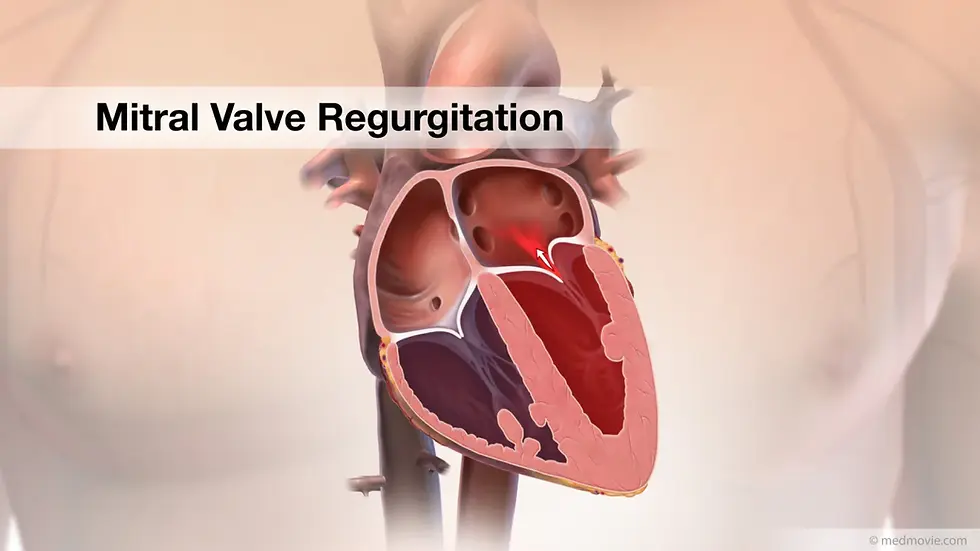Assessing the Clinical Impact of Severe Aortic Stenosis Versus Severe Mitral Regurgitation
- Shane Yole
- Aug 13
- 3 min read
Severe Aortic Stenosis (AS) and Severe Mitral Regurgitation (MR) are serious heart conditions that can lead to life-threatening complications if not treated properly. While both conditions impair the heart's function, they do so in distinct ways. Understanding their clinical implications is vital for healthcare professionals and patients alike. This post will compare Severe Aortic Stenosis with Severe Mitral Regurgitation by examining their causes, symptoms, diagnostic methods, and treatment options.

Understanding Severe Aortic Stenosis
Severe Aortic Stenosis is marked by the narrowing of the aortic valve, which restricts blood flow from the heart to the rest of the body. This condition often arises from age-related calcification of the valve, with studies indicating that around 4% of individuals over 75 years have severe AS.
Typical symptoms of Severe Aortic Stenosis include:
Shortness of breath during physical activity or exertion
Chest pain or feelings of tightness
Fatigue or decreased exercise tolerance
Dizziness or fainting spells
As the condition progresses, it can lead to severe complications, including heart failure, arrhythmias, and a significantly increased risk of sudden cardiac death, with estimates suggesting that nearly 50% of untreated patients die within two years of symptom onset.
Diagnosis generally involves echocardiography, providing images of the heart's structure and function, with supplemental assessments including electrocardiograms (ECGs) and sometimes cardiac catheterization.
Treatment for Severe Aortic Stenosis varies based on its severity and patient health. Surgical interventions, most notably aortic valve replacement, are common for severe cases. Transcatheter Aortic Valve Replacement (TAVR) has become a popular, less invasive alternative for high-risk patients, resulting in a 30-day mortality rate of around 3.4% compared to 7.5% for surgical approaches.

Understanding Severe Mitral Regurgitation
Severe Mitral Regurgitation happens when the mitral valve does not close properly, allowing blood to flow backward into the left atrium during heart contractions. This condition can be attributed to degenerative valve disease, ischemic heart disease, and rheumatic fever, which collectively affect thousands of patients annually.
Symptoms can include:
Shortness of breath, especially during exertion or lying flat
Fatigue during routine activities
Palpitations or irregular heartbeats
Swelling in the legs or abdomen
Complications from Severe Mitral Regurgitation can be equally grave, leading to heart failure and atrial fibrillation. A study found that untreated MR can result in nearly 40% of patients developing heart failure symptoms within five years.
Diagnosing this condition relies predominantly on echocardiography, which evaluates the severity of regurgitation and heart function. Other assessments, such as chest X-rays and MRIs, may also be employed for a comprehensive view.
Treatment of Severe Mitral Regurgitation typically includes surgical repair or replacement of the mitral valve, especially in patients with significant symptoms. Innovations in minimally invasive techniques have been developed to enhance recovery experiences.

Comparing Clinical Impacts
When evaluating the clinical impacts of Severe Aortic Stenosis and Severe Mitral Regurgitation, several essential factors emerge, including symptom severity, disease progression, and treatment outcomes.
Symptom Severity
Both conditions can lead to overlapping symptoms, like shortness of breath and fatigue. However, the manner and pace at which these symptoms manifest can differ significantly. Severe Aortic Stenosis often results in acute symptoms due to a swift drop in cardiac output. Conversely, Severe Mitral Regurgitation may have chronic symptoms that develop insidiously over months or years, making timely detection crucial.
Disease Progression
The progression of Severe Aortic Stenosis is generally more predictable, allowing for a clear timeline of decline. Research shows that patients often experience a rapid downturn in health within six months post-symptom onset if untreated. In contrast, Severe Mitral Regurgitation can exhibit unpredictable trajectories based on individual factors and underlying causes, demanding personalized approaches to management.
Treatment Outcomes
Over the years, surgical results for both conditions have improved markedly. Aortic valve replacement, whether through surgery or TAVR, shows positive outcomes, with approximately 85% of patients experiencing significant symptom relief post-procedure. Similarly, mitral valve repair or replacement has a success rate exceeding 90%, particularly if performed before severe heart failure develops.
Final Thoughts on the Comparison
Ultimately, both Severe Aortic Stenosis and Severe Mitral Regurgitation are critical cardiac conditions necessitating vigilant evaluation and management. While Severe Aortic Stenosis is often associated with more acute symptoms and predictable progression, Severe Mitral Regurgitation can pose chronic challenges that may also be debilitating.
The significance of each condition varies based on patient-specific factors such as age, comorbidities, and overall health. Healthcare professionals must carefully assess each situation to determine the most suitable treatment options.
Awareness of these conditions is essential for both patients and healthcare providers. Recognizing the signs, seeking timely diagnosis, and exploring treatment strategies can empower individuals to take proactive steps in managing their heart health effectively. Improving education in cardiology is key to enhancing patient outcomes and overall quality of life.










Comments